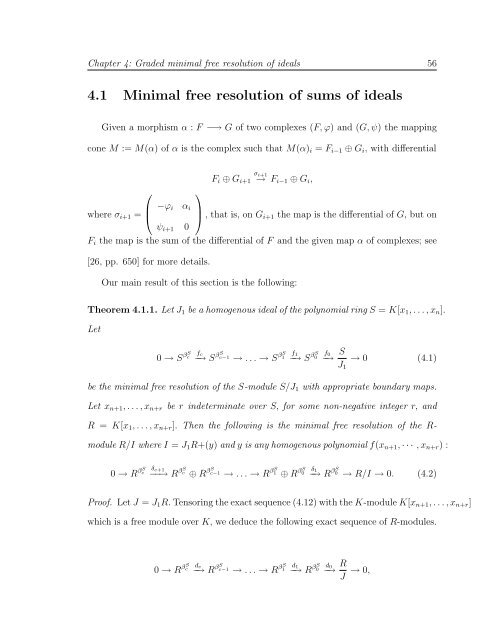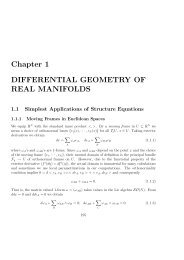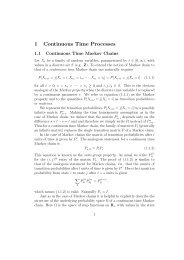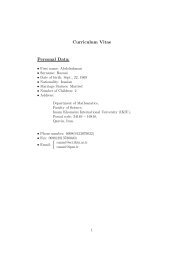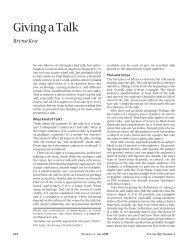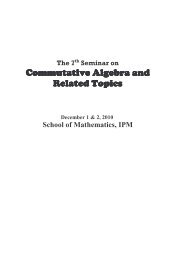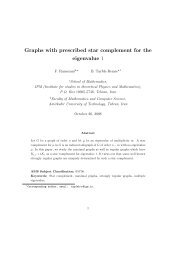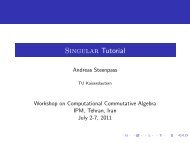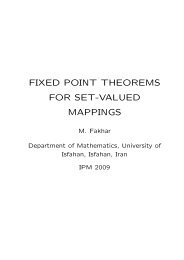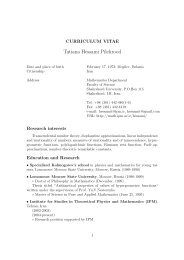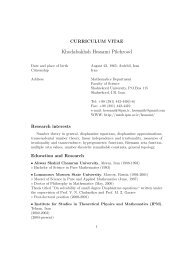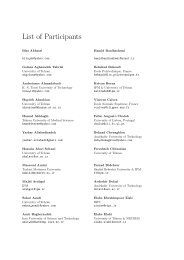Betti numbers of modules over Noetherian rings with ... - IPM
Betti numbers of modules over Noetherian rings with ... - IPM
Betti numbers of modules over Noetherian rings with ... - IPM
You also want an ePaper? Increase the reach of your titles
YUMPU automatically turns print PDFs into web optimized ePapers that Google loves.
Chapter 4: Graded minimal free resolution <strong>of</strong> ideals 56<br />
4.1 Minimal free resolution <strong>of</strong> sums <strong>of</strong> ideals<br />
Given a morphism α : F −→ G <strong>of</strong> two complexes (F, ϕ) and (G, ψ) the mapping<br />
cone M := M(α) <strong>of</strong> α is the complex such that M(α)i = Fi−1 ⊕ Gi, <strong>with</strong> differential<br />
where σi+1 =<br />
⎛<br />
⎜<br />
⎝ −ϕi αi<br />
ψi+1 0<br />
⎞<br />
Fi ⊕ Gi+1<br />
σi+1<br />
→ Fi−1 ⊕ Gi,<br />
⎟<br />
⎠ , that is, on Gi+1 the map is the differential <strong>of</strong> G, but on<br />
Fi the map is the sum <strong>of</strong> the differential <strong>of</strong> F and the given map α <strong>of</strong> complexes; see<br />
[26, pp. 650] for more details.<br />
Our main result <strong>of</strong> this section is the following:<br />
Theorem 4.1.1. Let J1 be a homogenous ideal <strong>of</strong> the polynomial ring S = K[x1, . . . , xn].<br />
Let<br />
0 → S βS c<br />
fc<br />
−→ S βS c−1 → . . . → S βS 1<br />
f1<br />
−→ S βS 0<br />
f0<br />
−→ S<br />
J1<br />
→ 0 (4.1)<br />
be the minimal free resolution <strong>of</strong> the S-module S/J1 <strong>with</strong> appropriate boundary maps.<br />
Let xn+1, . . . , xn+r be r indeterminate <strong>over</strong> S, for some non-negative integer r, and<br />
R = K[x1, . . . , xn+r]. Then the following is the minimal free resolution <strong>of</strong> the R-<br />
module R/I where I = J1R+(y) and y is any homogenous polynomial f(xn+1, · · · , xn+r) :<br />
0 → R βS c<br />
δc+1<br />
−−→ R βS c ⊕ R βS c−1 → . . . → R βS 1 ⊕ R βS 0<br />
δ1<br />
−→ R βS 0 → R/I → 0. (4.2)<br />
Pro<strong>of</strong>. Let J = J1R. Tensoring the exact sequence (4.12) <strong>with</strong> the K-module K[xn+1, . . . , xn+r]<br />
which is a free module <strong>over</strong> K, we deduce the following exact sequence <strong>of</strong> R-<strong>modules</strong>.<br />
0 → R βS c<br />
dc<br />
−→ R βS c−1 → . . . → R βS 1 d1 β<br />
−→ R S 0 d0 R<br />
−→<br />
J<br />
→ 0,


